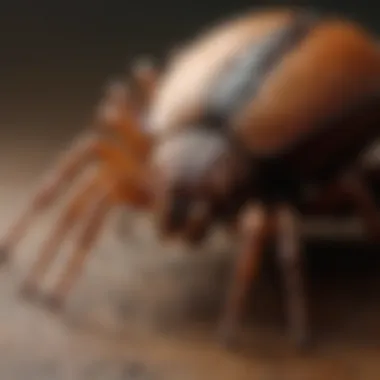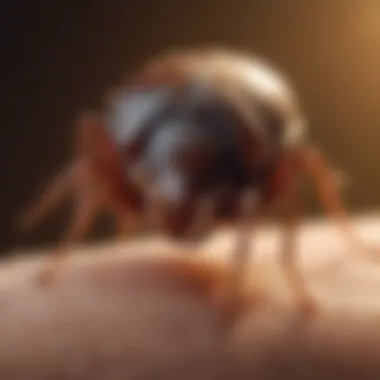Safely Removing a Tick: A Comprehensive Guide


Intro
Ticks are more than just a nuisance for those who enjoy the great outdoors; they can pose serious health risks. Understanding ticks, how to safely remove them, and ways to prevent their bites are essential skills. In this section, we will outline crucial points regarding tick identification, diagnosis of infestations, preventative strategies, and treatment options.
Whether you are an avid hiker or simply enjoy spending time in your garden, knowing how to manage ticks is vital for your safety. This article delivers a comprehensive look at each element involved in dealing with ticks, ensuring that you are well-equipped for any outdoor activities.
Understanding Ticks
Ticks are small arachnids that pose significant health risks, especially for those who spend time outdoors. Knowing about ticks is crucial for effective prevention and removal. Understanding the specific types of ticks, their habits, and their life cycle is essential. This knowledge allows individuals to take proper precautionary measures against potential tick bites and related diseases.
Types of Ticks
Ticks generally fall into two main categories: hard ticks and soft ticks. Knowing the differences helps in understanding their behavior and the risks associated with them.
Hard Ticks
Hard ticks feature a tough exterior and are more commonly found in various habitats. One key characteristic of hard ticks is the presence of a scutum, which is the hard shield-like covering on their back. This feature makes hard ticks easier to identify from a distance. These ticks are significant because many species, such as the black-legged tick, transmit diseases like Lyme disease. The way they attach to hosts increases the risk of disease transmission, making knowledge about them crucial.
Soft Ticks
Soft ticks, in contrast, lack a scutum and tend to have a softer appearance. A notable characteristic of soft ticks is that they often feed at night, which can catch people off guard. While they are less likely to transmit Lyme disease, they can carry other pathogens leading to illnesses like Tick-Borne Relapsing Fever. Understanding the behavior of soft ticks can help in managing outdoor activities, especially during dusk and nighttime.
Tick Habitats
Ticks thrive in various environments, primarily in forests, woodlands, grasslands, and gardens. Being aware of these habitats enables individuals to avoid areas where tick encounters are more likely.
Forests and Woodlands
Forests and woodlands provide ideal habitats for ticks, as dense foliage offers protection and moisture. These areas are typically rich in wildlife, which serves as hosts for ticks. As a result, they increase tick populations. Knowing this, individuals should take extra precautions when engaging in outdoor activities in such regions, such as wearing appropriate clothing and using repellents.
Grasslands and Gardens
Grasslands and gardens can also harbor ticks, especially near tall grasses and shrubs. Ticks tend to quest on the tips of these grasses, waiting for a host to pass by. They can be equally as dangerous as those found in wooded areas. Ensuring regular maintenance and monitoring of such spaces can reduce tick populations and enhance safety for children and pets.
Tick Life Cycle
Comprehending the tick life cycle is imperative for effective prevention strategies. It consists of four stages: egg, larva, nymph, and adult. Each stage poses different risks for host attachment and disease transmission.
Egg Stage
The egg stage occurs in the spring and early summer months. During this time, female ticks lay hundreds of eggs in moist environments. Recognizing this stage is essential, as the presence of eggs indicates upcoming populations and the potential for increased bite risks.
Larval Stage
Larvae emerge from the eggs and are extremely small. During this stage, they usually latch onto small mammals or birds for their first blood meal. Their size makes them harder to spot, heightening the risk of being bitten without realizing.
Nymph Stage
The nymph is a critical stage for disease risk. These young ticks are still small but can effectively transmit various diseases after feeding. Understanding their role is vital because they often go unnoticed until after a bite occurs, emphasizing the need for continued vigilance during this period.
Adult Stage
Finally, adult ticks are more visible and capable of transmitting Lyme disease and other infections. They often search for larger hosts, such as humans and pets. Understanding that adult ticks pose the highest risk is important for effective prevention strategies, particularly in late spring and summer when they are most active.
Importance of Tick Removal
Ticks are not just a nuisance; they pose a significant health risk to humans and animals alike. Understanding the importance of removing ticks promptly and properly is key to protecting oneself and loved ones from potentially severe illnesses. The presence of ticks can indicate an underlying ecological issue, and frequent encounters in certain environments highlight the need for vigilance and education.


Health Risks Associated with Ticks
Ticks are vectors for several serious diseases. Their small size often makes them easy to overlook, but their ability to transmit pathogens can lead to long-term health issues. It is crucial to understand these risks to motivate proactive measures in tick removal.
Lyme Disease
Lyme disease is the most commonly reported tick-borne illness in many parts of the world, especially in the United States. This disease is caused by the bacterium Borrelia burgdorferi, which ticks transmit when they feed on a host. A key characteristic of Lyme disease is its diverse range of symptoms, which may include fever, fatigue, and joint pain.
The unique feature of Lyme disease is the "bull's-eye" rash that can develop around the bite site. Early recognition and treatment are essential in preventing chronic health complications. Thus, for this article, Lyme disease serves as a primary focus due to its prevalence and the serious nature of its consequences if left untreated.
Rocky Mountain Spotted Fever
Another significant disease spread by ticks is Rocky Mountain spotted fever, caused by the bacterium Rickettsia rickettsii. This illness is characterized by sudden onset of fever, headache, and a distinctive rash that can appear several days after the bite. It is imperative to understand that this disease can be fatal if not treated promptly.
Rocky Mountain spotted fever is a beneficial focus in this guide due to its relatively rapid progression and severe implications if ignored. Both Lyme disease and Rocky Mountain spotted fever offer compelling reasons for raising awareness about tick removal.
Consequences of Improper Removal
Failing to remove ticks properly can have dire consequences, leading to infection or the continuation of disease transmission. Understanding these risks reinforces the need for an effective and safe removal strategy, encouraging individuals to act swiftly and correctly.
Infection Risks
When ticks are removed incorrectly, there is a heightened risk of infection. This can occur when the tick's mouth parts are left embedded in the skin. The key concern is that these mouthparts can introduce bacteria into the bloodstream, leading to localized infections or other complications. This consideration makes understanding proper tick removal techniques paramount for public health.
Continued Transmission of Diseases
Another critical aspect of improper tick removal is the potential for continued transmission of tick-borne diseases. If a tick is removed but not entirely, it may still harbor pathogens that can enter the host's body. This ongoing risk emphasizes the need for thorough techniques in tick removal, underlining the importance of educating the public on effective methods.
Prompt and correct tick removal is not just a recommendation; it is a necessity to prevent severe health outcomes.
In summary, understanding the importance of tick removal helps underscore the broader implications for personal and public health. By addressing the health risks and consequences of improper actions, we highlight not only a preventative measure but also a call for education and preparedness.
Tools for Tick Removal
The removal of ticks necessitates certain tools that ensure efficiency and safety. The right tools can significantly reduce the risks of improper removal. To effectively extract a tick, understanding the significance and benefits of various tools becomes essential. The following sections outline both essential and optional tools that aid in tick removal and provide important aftercare.
Essential Tools
Fine-Tipped Tweezers
Fine-tipped tweezers are crucial in the safe removal of ticks. Their specific aspect lies in their design, allowing for precise grip and manipulation of small objects, such as ticks. The key characteristic of fine-tipped tweezers is their narrow tips that allow for close contact with the skin. This feature is particularly beneficial because it lowers the chance of squeezing the tick, which can increase the risk of disease transmission. Moreover, their advantage lies in the ability to firmly grasp the tick as close to the skin as possible, ensuring the head is pulled out along with the body. The only disadvantage is that they may require a steady hand and some practice to use effectively, especially for individuals who are new to tick removal.
Tick Removal Tool
A tick removal tool specifically designed for this purpose is another highly effective method for safely extracting ticks. This tool's key characteristic is its unique design, often featuring a curved edge intended to slide under the tick. The rationale for using a tick removal tool is that it minimizes the risk of leaving parts of the tick embedded in the skin, which can lead to infection. The unique feature of these tools is their simple operation; they allow users to lift the tick straight out, maintaining the integrity of the skin and reducing the likelihood of irritation. While effective, these tools can sometimes be less accessible, as they are not typically found in every household, but having one on hand for outdoor activities increases preparedness.
Optional Tools
Disinfectant
Disinfectant serves a significant role in post-removal care. Its primary aspect is to clean the area where the tick was attached. The key characteristic of disinfectants is their wide spectrum of efficacy against bacteria and viruses. Using a disinfectant after tick removal is crucial as it prepares the skin for healing and reduces the risk of infection. The advantage of this tool lies in preventing local infections that can occur from bacteria present on the tick or in the skin's flora. However, it is important to choose a disinfectant that is safe for skin application to avoid irritation, especially for those with sensitive skin.
Gloves
Gloves offer an added layer of protection during tick removal that should not be overlooked. Their specific aspect is the barrier they create between the remover and the tick. The key characteristic of wearing gloves is that it prevents direct contact with any pathogens the tick may carry. This can be especially beneficial for those who may have allergies or sensitivities. Additionally, the unique feature of gloves is that they can be disposed of afterward, ensuring that any contaminated material does not come into contact with the skin. The only downside is that they may limit dexterity slightly, making fine movements more challenging. Nevertheless, the protection they provide against possible exposure during tick handling is invaluable.
Techniques for Safe Tick Removal


Techniques for removing ticks are vital in ensuring the safety and health of individuals who spend time in outdoor environments. Understanding proper removal strategies minimizes the risk of tick-borne diseases. This section illustrates detailed techniques for removing ticks safely and effectively. It also highlights the factors that influence successful removal and the importance of careful handling in preventing infections.
Step-by-Step Removal Process
Identifying the Tick
Identifying the tick is the first crucial step in the removal process. Recognizing tick species provides insight into potential disease transmission. Common varieties include the black-legged tick and the dog tick. Each type varies slightly in appearance. For instance, the black-legged tick is small, sometimes as tiny as a poppy seed. Knowing how to identify ticks helps in making informed decisions regarding their removal. If misidentified, some individuals may assume a pest is harmless, resulting in delayed action.
Grasping the Tick
Grasping the tick properly is essential for effective removal. Using fine-tipped tweezers or a tick removal tool is recommended. This careful grip needs to be as close to the skin's surface as possible. It prevents the tick's mouthparts from breaking off and remaining embedded. Many prefer using tweezers because they provide precision. However, improper techniques can lead to squeezing the tick, which may increase the risk of disease transmission.
Removing the Tick
The removal action should be steady and smooth to ensure the entire tick is taken out. Avoid jerkiness during the process, as this can also lead to mouthparts detaching from the tick. A direct upward motion is ideal. After the tick is fully removed, it should be placed in a sealed container for later identification if necessary. The method is straightforward but must be executed with care to minimize any health risks.
Cleaning the Area
Cleaning the bite area after tick removal is a critical part of aftercare. Disinfectants, like rubbing alcohol, should be used to clean the site. This step reduces the possibility of infections that may arise from broken skin or tick saliva. Monitoring the area for other signs of infection is recommended. Making this part of the process ensures that you take additional precautions against the aftermath of a tick encounter.
What to Avoid During Removal
Improper techniques may worsen any potential risks. Here’s what to keep in mind:
Using Heat
Using heat to deter the tick may seem logical, but this can lead to adverse effects. Heat can cause the tick to burrow deeper or regurgitate its contents into the bite, increasing the risk of disease transmission. Avoid heat sources like matches or hot objects, as they do not effectively detach the tick from skin and can complicate the removal process.
Applying Chemicals
Applying chemicals, such as pesticides or alcohol directly onto the tick can be ineffective and dangerous. Such substances may irritate the skin or lead to allergic reactions. Chemicals can also confuse the tick, potentially causing it to bite harder or release more saliva. It is best to rely on proper mechanical removal methods instead.
Post-Removal Guidelines
Understanding the post-removal guidelines after tick removal is essential. This section details key steps to ensure that the affected area is monitored carefully and any signs of complications are addressed promptly. Proper aftercare reduces the risk of infections and other tick-borne diseases.
Monitoring for Symptoms
Monitoring after tick removal is crucial. It helps in identifying any adverse reactions that may arise from the bite or the removal process itself. There are two primary categories of symptoms to watch for: local reactions and systemic symptoms.
Local Reactions
Local reactions are immediate responses that occur at the site of the tick bite. In most cases, this manifests as redness, swelling, or itching. The main characteristic of local reactions is that they usually indicate the body’s response to the tick’s saliva or the injury caused during removal. It is important to observe any changes surrounding the bite area in the first few days after removal.
Local reactions are often benign, but monitoring them can help distinguish between minor irritation and more concerning symptoms. A unique feature of local reactions is that they can be alleviated with over-the-counter antihistamines if itching or swelling becomes uncomfortable. However, if the redness persists or expands significantly, it may signal an infection. Identifying this early is beneficial, as it allows for timely intervention.
Systemic Symptoms
Systemic symptoms pertain to reactions that occur throughout the body rather than just at the site of the bite. These symptoms may include fever, fatigue, headache, or muscle aches. The key characteristic of systemic symptoms is that they could indicate a more serious tick-borne illness like Lyme disease or Rocky Mountain spotted fever.
Recognizing systemic symptoms is essential for timely diagnosis and treatment. Unique features of systemic symptoms are that they may appear days to weeks after the initial tick removal. This slow onset means a person can easily overlook the connection to the tick bite. Understanding this delay is crucial, especially for those with a history or high risk of tick exposure. If one experiences any systemic symptoms, seeking medical advice promptly is essential to enhance treatment outcome.
When to Seek Medical Attention
Knowing when to seek medical care after a tick bite can be crucial. Some signs require immediate attention to prevent complications of tick-borne diseases. Here are two main areas to consider: signs of infections and potential tick-borne illnesses.
Signs of Infection


Signs of infection can occur at the site of the tick bite or systemic signs throughout the body. Common indicators include increased redness, warmth, and pus formation at the bite site. The importance of identifying these signs early cannot be overstated. If left unchecked, an infection could develop into a more severe condition.
The distinguishing characteristic of infection signs is that they often develop within a few days to weeks following the bite. Monitoring the area and being aware of changes is crucial for housewives and homeowners who spend time outdoors. A unique aspect of recognizing signs of infection is that it allows for early intervention with antibiotics, which can significantly improve outcomes.
Potential Tick-Borne Illness
Potential tick-borne illnesses are serious and can have long-lasting effects if undiagnosed. Symptoms such as high fever, joint pain, and severe headaches may indicate a tick-borne illness. Being able to recognize these conditions earlier can lead to quicker treatment. Lyme disease, for instance, is well known, but there are others like anaplasmosis or babesiosis.
The key factor of potential tick-borne illness is the timeline of symptom onset. Some illnesses can manifest weeks after the bite, making it challenging to connect the symptoms back to the tick exposure. Educating oneself about these possible diseases is a beneficial choice to keep family and loved ones safe. If such symptoms arise, consult a healthcare professional immediately, because prompt treatment is critical.
Preventive Measures Against Tick Bites
Preventive measures against tick bites are essential for anyone who spends time outdoors. Ticks can transmit various diseases, therefore, employing strategies to avoid encounters with them is crucial. The implications of effective preventive methods extend beyond personal health; they contribute to community well-being. Proper measures can minimize the risk of serious illness and ensure a safer outdoor experience.
Personal Protective Equipment
Long Sleeves and Pants
Wearing long sleeves and pants is a straightforward yet effective strategy to protect against tick bites. This clothing choice acts as a physical barrier, reducing the likelihood of ticks making contact with the skin. It is especially beneficial in areas with high tick populations, such as forests or tall grass. One key characteristic that makes this strategy popular among outdoor enthusiasts is its simplicity.
The unique feature of long sleeves and pants is that they cover exposed skin and limit access for ticks. This approach is advantageous, especially for individuals who frequently engage in activities in tick-infested areas. However, it can be less comfortable in warm weather unless lightweight, breathable fabrics are worn.
Tick Repellents
Tick repellents are another vital personal protective equipment consideration. These products contain active ingredients such as DEET or picaridin, which deter ticks from attaching. Their effectiveness makes them a popular choice among hikers, campers, and others who enjoy the outdoors.
The unique feature of tick repellents is their ability to repel not only ticks but also other biting insects. Applying these products to exposed skin and clothing can significantly reduce the risk of bites. However, it is essential to choose a repellent that ensures both safety and efficacy, as some may have side effects or require frequent reapplication.
Environmental Management
Yard Maintenance
Yard maintenance plays a crucial role in preventing tick populations from thriving near homes. Regularly mowing the lawn and clearing away debris can significantly reduce tick habitats. The key characteristic of this approach is that it requires physical effort and ongoing attention.
Well-maintained yards are less inviting to ticks. This preventative strategy is beneficial because it not only protects residents but also minimizes the risk of ticks spreading to neighboring areas. However, some might find it challenging to keep up with this task, especially in the case of larger properties.
Regular Inspection of Pets
Regular inspection of pets is another necessary measure to prevent ticks. Pets often wander into areas where ticks are abundant and can bring them back into the home. The key characteristic of this practice is its straightforward nature; pet owners can easily incorporate it into their routine.
Regularly checking pets for ticks after outdoor activities can help catch infestations early. This preventative measure is advantageous as it protects both pets and humans. However, some pet owners may overlook this practice, leading to unintentional tick infestations within the household.
Employing preventive measures against tick bites can significantly diminish health risks associated with tick-borne diseases, ensuring a safer environment for families and communities.
Epilogue
The conclusion serves as a pivotal element in this guide, reinforcing the critical nature of properly removing ticks. Understanding the nuances of tick management not only empowers individuals but also fosters a broader sense of community health awareness. Since ticks can transmit various diseases, including Lyme disease and Rocky Mountain spotted fever, effective removal techniques can prevent potential infections. Moreover, this knowledge encourages people to take actionable preventive measures in their daily lives, enhancing their safety during outdoor activities.
In summation, the benefits of mastering tick removal are manifold. First, knowing how to accurately identify and remove a tick demonstrates an essential self-care skill. This promotes personal well-being and builds confidence in addressing similar challenges that may arise in nature. Additionally, effectively communicating this information within your community can increase collective awareness and vigilance against tick-borne threats.
It is necessary to consider the possibility of ticks being more prevalent in some regions, and the growing concern surrounding tick-borne illnesses cannot be understated. Being equipped with the right knowledge and tools answers this pressing need. Therefore, taking steps to continually educate oneself on tick management can significantly lower exposure risks.
"An ounce of prevention is worth a pound of cure." This wisdom particularly applies to tick safety, as preemptive actions can stave off more serious health issues in the future.
Summary of Key Points
- Importance of Safe Removal: Proper techniques can greatly reduce the risk of infection and disease transmission.
- Comprehensive Understanding: Familiarity with ticks, their habitats, and life cycles assists in effective prevention and removal.
- Post-Removal Care: Monitoring symptoms post-removal ensures early detection of potential health issues.
- Tools and Techniques: Utilizing the right tools and following best practices can enhance effectiveness in tick management.
- Preventive Measures: Personal and environmental precautions can significantly decrease the chances of tick encounters.
Encouragement for Vigilance
Staying vigilant in the fight against ticks is essential for anyone who spends time outdoors. This attentive approach involves regularly checking oneself after outdoor excursions, maintaining awareness of tick prevalence in particular areas, and adopting preventive gear such as tick repellents or proper clothing.
Creating safe environments around your home, particularly if you have pets, includes maintaining your yard and regularly inspecting animals. Remember, you have an active role in safeguarding not just yourself but also your family and pets. Commitment to tick management today will lead to fewer health issues tomorrow. Stay informed and proactive to ensure your health and the health of those you care about.



